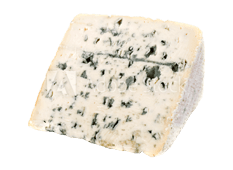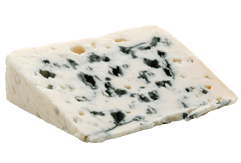These cheeses with often pronounced flavours all have mould inside, which forms colourful veins from blue to emerald green. Some moulds occur naturally in ripening cellars, for others the curds are mixed with strains of mould. Blue cheeses ripen from the centre, so the outside of the cheese is generally white without veins.
 BLEU D'AUVERGNE AOP
BLEU D'AUVERGNE AOP
Bleu d’Auvergne has a yellow-orange rind with a white down. The cheese itself is moist and shiny. It also has green mould which develops in the cavities. Its flavours are mainly salty with aromas of blue cheese and mushroom. It is a strong cheese.

 FOURME D'AMBERT AOP
FOURME D'AMBERT AOP
Fourme d’Ambert is a blue cheese. Its grey rind hides an ivory cheese with little blue marks. Fourme d’Ambert is slightly salty and has the characteristic flavour of blue cheese, a powerful taste.

 ROQUEFORT AOP
ROQUEFORT AOP
Roquefort is the most famous cheese in the world! Its ivory surface is very moist. It comes wrapped in aluminium. It has many cavities in which Penicillium roqueforti develops, which gives the cheese its powerful salty aromas with subtle notes of sheep’s milk.

